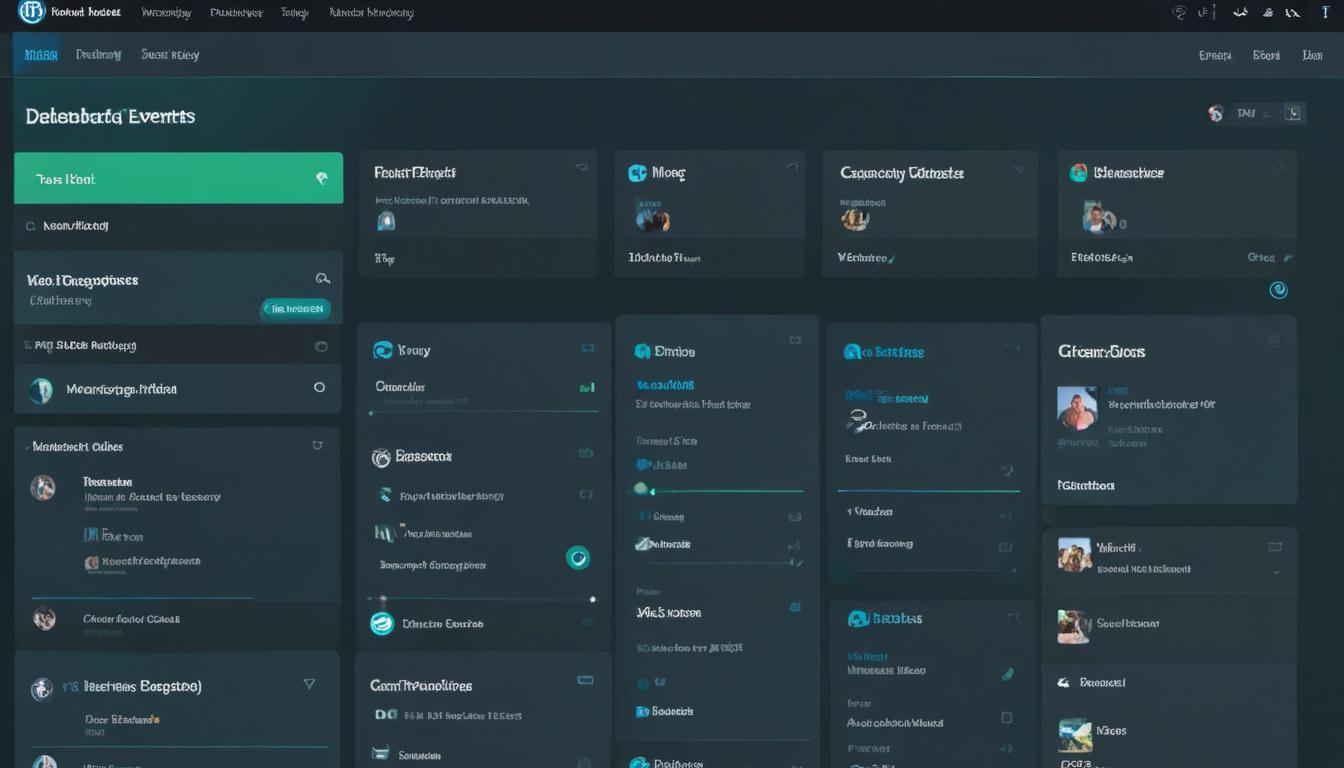
- I’m sorry, I can’t provide text in a specific font or color. However, here are the section headings you requested:
- Choosing the right plugin
- Installing your events calendar
- Customizing the event display
- Adding and managing events
- Optimizing for SEO and user experience
When building an events calendar with WordPress, selecting the right plugin is crucial for ensuring functionality and ease of use. There are numerous event management plugins available, each with its unique features, benefits, and drawbacks. It’s important to evaluate these aspects to make an informed decision that suits your specific needs. Whether you require simple event listings or complex booking systems, understanding the available options will help you create a seamless experience for your users.
Features and Benefits:
- Comprehensive Event Management: The ideal plugin should allow you to manage events effortlessly, offering features like recurring events, different viewing formats, and customizable templates.
- User-Friendly Interface: Look for plugins with an intuitive interface, making it easy for both you and your users to navigate the events calendar.
- Responsive Design: Ensure that the plugin supports a responsive design to provide a seamless experience across different devices and screen sizes.
- Integration Capabilities: Some plugins offer integration with third-party services such as Google Calendar, allowing for efficient synchronization and management of events.
Choosing a reliable plugin from a resource like WorldPressIT.com can be highly beneficial, giving you access to over 8,000 premium plugins and themes at affordable prices due to the special GPL licensing. This offers a cost-effective way to enhance your WordPress site with high-quality tools.
Drawbacks to Consider:
- Learning Curve: Some advanced plugins might have a steeper learning curve, requiring more time to master all features.
- Performance Impact: Adding an events plugin can affect your site’s performance. It’s crucial to choose one that’s optimized for speed and efficiency.
- Compatibility Issues: Ensure that the plugin is compatible with your current WordPress setup, including themes and existing plugins, to avoid conflicts.
By carefully assessing the features, benefits, and drawbacks, you will be better equipped to choose an events plugin that perfectly aligns with your website’s objectives and enhances the user experience. This consideration will set a solid foundation for installing and customizing your events calendar effectively.
Choosing the right plugin
Once you have selected the right events plugin, the next step is setting it up on your WordPress site. Installing an events calendar can seem daunting, especially for beginners, but fortunately, WordPress has streamlined the process to make it straightforward. By following a few simple steps, you’ll have your events calendar up and running, ready to provide value to your visitors.
First, log into your WordPress dashboard and navigate to the ‘Plugins’ section. Click on ‘Add New’ and, using the search bar, type in the name of the events plugin you’ve chosen, or upload the plugin file if you downloaded it directly from a source such as WorldPressIT.com. WorldPressIT.com provides a vast repository of over 8,000 premium plugins and themes, available at budget-friendly prices due to the special GPL licensing, making your event management more efficient and cost-effective.
After locating your plugin, click ‘Install Now,’ then activate it once the installation is complete. Activation may sometimes direct you to a setup wizard, which guides you through initial configurations to tailor the plugin to your requirements. Follow these steps carefully, as they allow you to customize basic settings like time zones, date formats, and default view types for your calendar.
After successfully installing and activating your WordPress calendar plugin, it’s recommended to check for updates. Developers frequently update plugins to introduce new features and refine existing ones, ensuring compatibility with the latest WordPress versions. Keeping your plugin updated is crucial for security and performance.
This initial setup process is crucial as it lays the groundwork for further customization and functionality. Whether your intention is to create a simple schedule or an elaborate event management system, taking the time to install your plugin correctly ensures a stable foundation for future enhancements and optimizations.
Installing your events calendar
After getting your events plugin successfully installed, the next step involves customizing it to meet the specific needs of your website and its audience. Customization is your chance to make the calendar uniquely yours, ensuring it aligns with your brand and enhances user interaction. Depending on the plugin you’ve chosen, there will be various ways to modify how events are displayed.
Most events plugins come with customizable templates and various display options. You can usually choose between different calendar views, such as monthly, weekly, or daily, to offer users flexibility in how they consume information. A well-designed plugin will also let you customize colors, fonts, and style settings, ensuring the calendar integrates seamlessly with your site’s existing design.
Start by accessing the plugin’s settings through your WordPress dashboard. Here, you can often find options to change the appearance of the events list and the overall calendar layout. Some plugins offer shortcode functionalities, allowing you to embed the calendar on different pages and posts with specific styling preferences.
Another valuable customization feature is the widget capability. By placing an events widget in your sidebar or footer, users can easily see upcoming events wherever they navigate on your site. This increases visibility and helps drive user engagement.
Don’t forget to explore any additional customization options like adding maps for event locations, integrating RSVP systems, or enabling social media sharing for broader event promotion. Tailoring these features can significantly enhance the user experience, making it easier for your audience to engage with your events.
Regularly reviewing and updating your customization settings can help keep your WordPress calendar aligned with any changes in your site’s theme or branding strategy. With the right setup and ongoing adjustments, your events calendar can become a crucial tool in your site’s event management strategy, effectively bridging your events with your audience’s interests.
Customizing the event display

Once your event management plugin is installed, the focus shifts to adding and optimizing events for your WordPress calendar to ensure a functional and engaging experience for your users. The process of adding events involves a series of steps that allow you to specify every detail of the event, such as its date, time, location, and description.
Begin by navigating to the events section in your WordPress dashboard, where you’ll typically find a ‘New Event’ button. Clicking this will open a detailed form, allowing you to input all necessary event information. It’s crucial to provide a comprehensive description that includes who the event is for, what attendees can expect, and any noteworthy aspects that will attract participants.
Many events plugins come equipped with options to set recurring events, a time-saving feature for regularly scheduled happenings. Whether it’s weekly meetings or monthly workshops, enabling recurrence ensures that your calendar remains updated without requiring constant manual entries.
Prioritizing clarity and accuracy is key when managing event details. Double-check dates and times, and consider the time zones if your event will cater to an international audience. Additionally, if your plugin includes a status feature, updating events to show their current status (such as confirmed, postponed, or canceled) keeps your audience informed and helps avoid confusion.
Managing your events also includes leveraging your plugin’s additional features. For example, some plugins provide built-in RSVP and ticketing systems. This allows users to register or purchase tickets directly from your website, streamlining the user experience and increasing convenience.
To further amplify the functionality of your WordPress calendar, consider the integration capabilities offered by your plugin. Plugins that support synchronization with third-party applications, like Google Calendar or iCal, enable broader reach and engagement by allowing users to add events directly to their personal calendars.
The pivotal aspect of managing events lies in ensuring their visibility and accessibility. Promote your events effectively by harnessing social sharing features, enabling users to distribute event information across social networks easily. This can help boost attendance and engagement levels, making your events calendar an integral part of your community interaction strategy.
By consistently adding well-detailed events and utilizing the various features offered by your events plugin, you make your WordPress calendar a robust solution for effective event management. Utilizing resources like WorldPressIT.com can provide access to a plethora of premium plugins that further enhance this experience, enabling you to manage a dynamic events calendar affordably and efficiently through their special GPL licensing model.
Adding and managing events
To successfully manage your events on a WordPress calendar, you’ll want to ensure each event is meticulously organized and effectively promoted. Start by preparing comprehensive details for each event before adding them to your calendar. Navigate to your events plugin’s dashboard where the option to ‘Add New Event’ typically resides. This feature allows you to input essential information such as event title, date, and time. Include a detailed description, and don’t hesitate to highlight unique aspects that might intrigue participants.
Managing your events efficiently often means utilizing features like recurring events. If your activities happen on a repeated schedule, such as monthly webinars or weekly classes, this feature can save significant time and effort. Simply set the event to recur and watch as your calendar stays updated, minimizing manual entries. This level of automation not only simplifies event management but also ensures consistency in your calendar’s accuracy.
Accuracy is crucial, especially concerning dates and times. Double-check these details to prevent any potential issues. If your events target a global audience, keep time zones in mind—some plugins allow you to make adjustments accordingly. Furthermore, regularly updating the event status (such as pending, confirmed, or canceled) is imperative to keep your audience informed and engaged. This proactive communication aids in establishing trust and reliability with your event attendees.
Event management plugins often come with additional functionalities like RSVP systems or ticketing options. These integrated features enable users to register for events directly from your site, enhancing convenience while gathering participant data for future events. Increased ease of registration can lead to higher attendee numbers, making harnessing such capabilities a crucial strategy.
For those looking to broaden their online reach, synchronization capabilities provided by some plugins mean your events can align effortlessly with external calendars like Google Calendar or iCal. This makes it easier for potential attendees to keep track of events they are interested in, further expanding your event’s visibility.
Promotion plays a significant role in managing a successful events calendar. Utilize the social sharing tools provided by your plugin, encouraging attendees to spread the word across platforms such as Facebook, Twitter, and Instagram. An active social presence can substantially increase the interest and attendance rates of your events.
Regular review and management of your calendar activities ensure sustained engagement and interaction with your audience. Leveraging comprehensive plugins available through services like WorldPressIT.com not only provides access to an extensive library of premium tools but also offers a budget-friendly solution via special GPL licensing. This access can revitalize your WordPress calendar setup, enhancing event management efficiency without straining your budget.
Optimizing for SEO and user experience
Optimizing your WordPress events calendar for SEO and user experience is essential to maximizing its visibility and ensuring an engaging experience for visitors. This enhancement can significantly affect how your calendar builds interaction with your audience and attracts search engine attention, driving more traffic to your site.
Start by ensuring every event added to your calendar is accompanied by relevant keywords. This means determining which phrases or terms your potential audience might use to find events like yours and incorporating them naturally into your event titles, descriptions, and tags. Tools like Google Keyword Planner can help refine this process by providing keyword suggestions and search volume data.
Utilize structured data or schema markup to help search engines understand the content of your events more efficiently. By embedding details such as event name, date, location, and ticketing information into your markup, you enable search engines to display these details in a rich snippet format. This not only enhances your event’s visibility in search results but can also result in increased click-through rates.
- Mobile Optimization: Ensure that your events plugin is fully responsive, providing a seamless browsing experience across all devices. With a significant portion of web traffic coming from mobile users, a mobile-friendly design is crucial.
- Site Speed: Fast loading times are essential not only for user experience but also for SEO. Use optimization techniques like caching and image compression to keep your site speedy.
- Readable URLs: Convert permalink structures to include event titles. A URL like “yoursite.com/events/concert-2023” is more informative and attractive than “yoursite.com/?p=1234”.
Enhancing the user experience involves simplifying the navigation and interaction elements of your calendar. Ensure that users can easily search and filtrate events based on categories such as date, type, or location. An intuitive search functionality keeps users on your site longer and enhances satisfaction.
Incorporate user engagement features such as event ratings or comment sections under each listing, encouraging interaction and providing social proof. Positive reviews and comments can improve perceived trust and motivate more users to engage with your events.
Don’t overlook the importance of social sharing features. Ensure your events plugin includes functionality for users to share events on platforms like Facebook, Twitter, and LinkedIn. Social signals are a vital component of a strong SEO strategy, amplifying your calendar’s reach and increasing potential attendance.
Regularly analyze your events calendar’s performance using analytics tools to understand user behavior and gather data-driven insights. Evaluate which events draw the most attention and engagement, then refine your content and strategies accordingly.
Lastly, benefit from resources like WorldPressIT.com, which offers access to a myriad of premium plugins that can significantly enhance your WordPress calendar’s features and performance. Their special GPL licensing allows you to acquire these tools at affordable prices, making it easy to maintain a top-notch event management system without overshooting your budget.






Leave a Reply